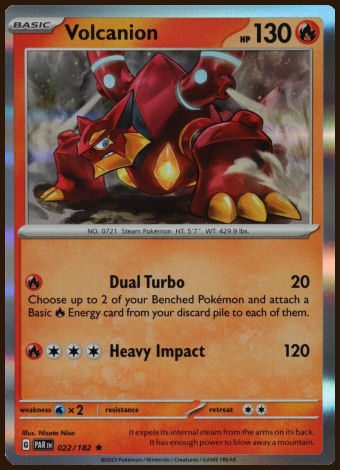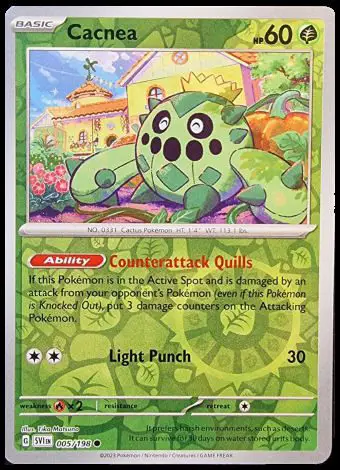Holo or Reverse Holo? How to tell the difference.
This page explains how to tell the difference between Holo or Reverse Holo cards used in the Pokémon Trading Card Game, with a view to making it easy to identify whether a card is a holo or reverse holo category and seeking to understand which type of card is preferred by fans of the TCG.
Contents
What is a Holo Card?
What is a Reverse Holo Card?
Which is Preferred – Holo or Reverse Holo?
What is a Holo Card?
A holo card, also known as holofoil or holo rare, is a regular trading card that has a holographic image at the top of the card instead of regular two dimensional art. Its rarity is indicated by a ★ next to its card number.

The Volcanion card, above, is from the Paradox Rift set that released in November 2023. It features the standard Holo Rare design for the Scarlet and Violet series which is Mirror Holo.
Holo cards have appeared in every set from the original base set released in 1999. Before 2011, when Half art and full art cards were introduced, holo cards were the rarest and most sought after cards.
The original holo cards had an image printed onto a thin layer of foil which gave it a shiny effect. Because of this these cards are sometimes referred to as holofoil, or holographic foil cards.
Each series has a particular holo pattern. The Volcanion card features the Scarlet and Violet Series Mirror Holo. Previous expansion series have featured different designs: Cosmos Holo, Confetti Holo, Cracked Ice and Vertical Lines.
What is a Reverse Holo Card?
A reverse holo card is a card that has a regular two-dimensional image at the top but the rest of the card is holographic. It is the reverse of a regular holo card hence its name.
Pokémon Reverse Holo cards first appeared in 2002 with the release of the Legendary Collection expansion set. They are not part of the main set of cards but form an alternative, parallel set of the non-holo cards in that particular set. There are no Reverse Holo versions of Holo Rare, Half Art or Full art cards.

Reverse Holo cards follow the rarity of their non-holo counterparts and can be rare, uncommon or common as indicated by the symbol next to the card number ★ indicates Rare, ◆ indicates Uncommon and ● indicates Common.
The Cacnea card above features the Reverse Holo pattern for the Scarlet and Violet series – a pattern featuring the symbol for that Pokémon’s type. Each series has a different Reverse Holographic pattern.
Which is Preferred – Holo or Reverse Holo Cards?
When Pokémon Trading Card Game launched in 1999, there were no art cards and Holo cards were the only holographic / shiny cards in the set. As such they were very popular and eagerly sought after by fans of the game and were often the highest valued cards of any set.
The introduction of art cards in the Black and White series reduced the popularity and value of Holo cards considerably, and that decline has continued to present day, with the exception of those that either feature a popular Pokémon character, or those with a particular pattern such as the very popular Cosmos Holo cards.
Reverse Holo cards launched in 2002 with the release of the Legendary Collection and have been a feature of every subsequent set released. The value of a Reverse Holo card depends on its rarity with the rare cards being worth considerably more than their common or uncommon counterparts. The Reverse Holo parallel component of a set contains significantly less cards that the main set and collectors will often seek to complete the Reverse Holo set rather than the main one.
In terms of preference for Holo or Reverse Holo cards, both are highly collectable and generally fetch a higher price than their non-holo counterparts. However, while collectors have always sought to complete sets of Reverse Holo cards, this is no longer the case with more recent Holo cards. That said, Holo cards from the original 1999 and 2000 expansion sets can be worth a considerable amount of money, particularly those that feature the Cosmos Holo pattern.









